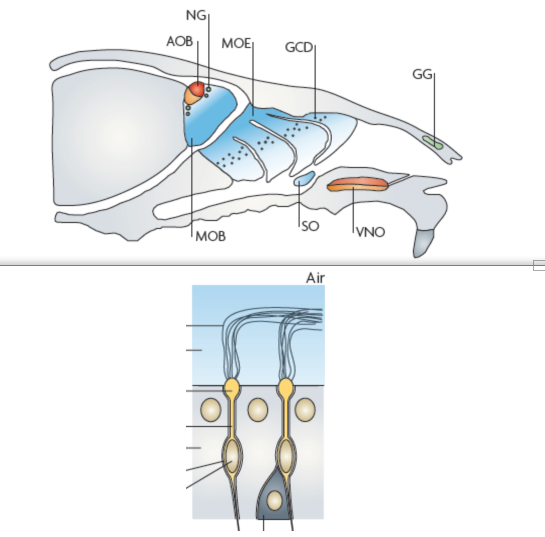 更多“2016年现代教育原理期末考试论述题1答案”相关的问题
更多“2016年现代教育原理期末考试论述题1答案”相关的问题
- Label each of the following structures on the diagram of the main olfactory epithelium (MOE) in rodent nasal cavity with 9 terms shown below: Cilia, ORNs (Olfactory receptor neurons), Dendrite, Dendritic knob, Nasal mucus, Axon, supporting cell, basal cell, Cell body.(9分)用所给的斜体9个英文短语在下图上相应位置上标出哺乳动物MOE的细胞结构名称

4. Finding Early Signs of Mad-Cow Disease(5分)
Disease damage: This microscopy image shows brain tissue damaged by Creutzfeldt-Jakob (可不译,照搬) disease. Researchers have made a list of blood proteins that act as early indicators of a group of diseases including bovine spongiform. encephalopathy (BSE), also known as mad-cow disease. The human form. of BSE, a fatal degenerative neurological disorder, called Creutzfeldt-Jakob disease
Biotech pioneer: Leroy Hood, president and cofounder of the Institute for Systems Biology, in Seattle, invented several tools, including the automated DNA sequencer that helped make it possible to sequence the human genome. Now, biotech pioneer Leroy Hood explains how Systems Biology will impact medicine.
1. “The Nobel Prize in Physiology or Medicine 2004”Press Release(15分)
4 October 2004
The Nobel Assemblyat Karolinska Institutet has today decided to award The Nobel Prize in Physiology or Medicine for 2004 jointly toRichard Axel and Linda B. Buckfor their discoveries of "odorant receptors and the organization of the olfactory system"
Summary
The sense of smell long remained the most enigmatic of our senses. The basic principles for recognizing and remembering about 10,000 different odours were not understood. This year's Nobel Laureates in Physiology or Medicine have solved this problem and in a series of pioneering studies clarified how our olfactory system works. They discovered a large gene family, comprised of some 1,000 different genes (three per cent of our genes) that give rise to an equivalent number of olfactory receptor types. These receptors are located on the olfactory receptor cells, which occupy a small area in the upper part of the nasal epithelium and detect the inhaled odorant molecules.
Each olfactory receptor cell possesses only one type of odorant receptor, and each receptor can detect a limited number of odorant substances. Our olfactory receptor cells are therefore highly specialized for a few odours. The cells send thin nerve processes directly to distinct micro domains, glomeruli, in the olfactory bulb, the primary olfactory area of the brain. Receptor cells carrying the same type of receptor send their nerve processes to the same glomerulus. From these micro domains in the olfactory bulb the information is relayed further to other parts of the brain, where the information from several olfactory receptors is combined, forming a pattern. Therefore, we can consciously experience the smell of a lilac flower in the spring and recall this olfactory memory at other times.
Richard Axel, New York, USA, and Linda Buck, Seattle, USA, published the fundamental paper jointly in 1991, in which they described the very large family of about one thousand genes for odorant receptors. Axel and Buck have since worked independent of each other, and they have in several elegant, often parallel, studies clarified the olfactory system, from the molecular level to the organization of the cells.
建筑材料期末考试计算题如下,求解
某混凝土采用下列参数:W/C=0.47,W=175KG/M3,pc=3.10,ps=2.55,pg=2.65,sp=0.29,按体积法计算该混凝土的配合比(引入空气量按1%计)


 如果结果不匹配,请
如果结果不匹配,请 

















